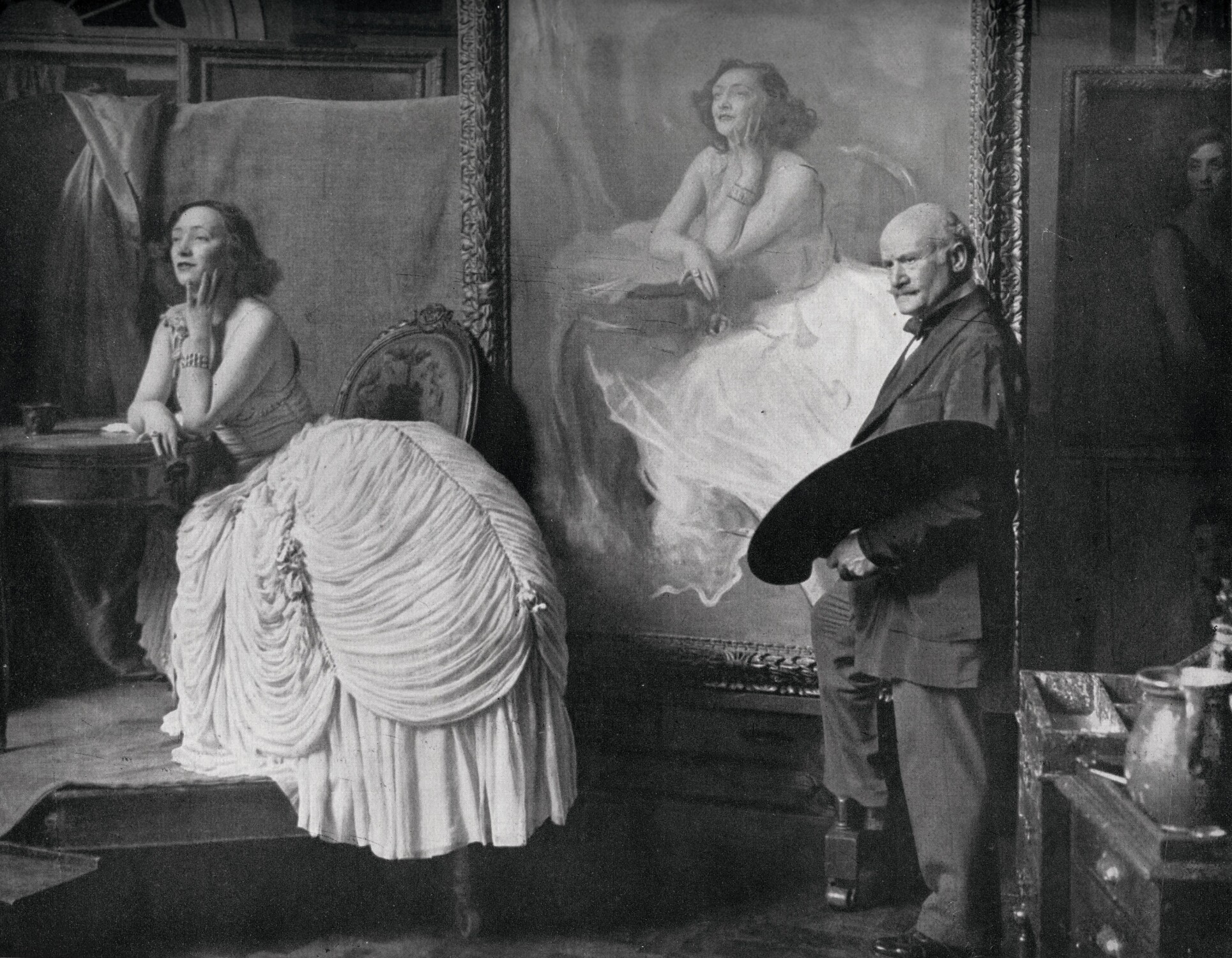This superb portrait depicts the flame-haired actress Anny Ahlers born in Hamburg on 22 December 1906, the daughter of Wilhelm Ahlers and Augusta Liebirg. Anny made her debut at the age of seven and her rise to fame was a steady ascent treading the boards at the Vienna Opera House where she was the première enfant-danseuse and then at the State Opera House in Berlin where she was a sensation.
A wealthy American impresario named Mr Scott with whom Anny had fallen madly in love, brought her to London in 1932 to appear at His Majesty’s Theatre in The Dubarry. She played the main part, based upon Jeanne Bécu, comtesse du Barry the last maîtresse-en-titre of King Louis XV of France who was put to death at the guillotine when found guilty of treason for assisting émigrés to flee from the French Revolution. Anny was a star on the London stage, applauded for her acting and adored for her beauty but she spoke little English and Mr Scott seems to have ignored her, paying her cheques for enormous amounts of money that she had little need or desire for. She had no relations or friends in London and was quite alone, overworked, under-loved and tormented by bouts of severe depression.
Whilst she was performing in The Dubarry in 1932, Anny was seen by Sir Merrik Burrell who had been taken to the performance by his daughter Dreda. He had recently divorced his second wife and was immediately smitten by Anny. He commissioned de László to paint a half-length portrait of her – the type of uninspiring portrait that was hung in the entrance lobbies of theatres to be admired by admiring star-gazers. When de László himself met the young actress he knew he could do better and painted Anny in the present glittering, elegant ‘swagger portrait’. He captured the shimmering starlight of a woman who could command the attention of an entire audience with her voice and beauty. She was dressed in late Eighteenth Century-style stage costume of Jeanne and there is a wonderful photograph of de László and Ahlers in his studio as she posed for him (Fig. 1). Burrell did not want to arouse scandal and was clear that de László should not reveal who had asked him to paint the portrait. Merrik gave her an emerald ring as a sign of his admiration for her and it is the same one that glints on her left hand in the portrait - it remains in the possession of the Burrell family.

Fatigued and unhappy Anny missed several of her appointments to sit for de László which greatly upset and frustrated him. Then, on 14 March 1933, the twenty-six year old Anny had a fatal fall from the balcony of her room next to His Majesty’s Theatre in Haymarket, London. De László had not finished the portrait but Dreda Burrell was persuaded to put on Anny’s stage costume and sit for the completion of the painting. According to her de László completed the hands, shoulders and silver slippers as Dreda posed for him.
When the portrait was exhibited at Knoedler’s gallery only a few months after Anny’s tragic death, under the title The Late Miss Anny Ahlers, it was a phenomenal popular success, no doubt because Anny’s death was so fresh in the minds of the public. Coloured reproductions of it were sold in aid of the Artists’ Benevolent Fund and thus its popularity spread widely. The Daily Mail summed it up: ‘by the liveliness of Mr de László’s rendering [it is] a melancholy reminder of the fragility of life.’1 The Star stated that ‘ever since the exhibition opened the portrait of poor Anny Ahlers has been the centre of an admiring group, and a bowl of Du Barry roses stands in front of it.’2
The portrait was given by de László to Burrell as a memento, refusing payment for it. He also made a chalk sketch of Dreda to thank her for making it possible for him to complete the picture. As a result of this commission De László and Sir Merrik became close friends. Although Sir Merrick found the portrait a little too large for his country home, Floodgates in Sussex, it was none-the-less hung and adored.
Exactly what Sir Merrick Burrell’s feelings for Anny were, we shall never know. He may have been in love with her or he may simply have had an infatuation with her fame. He had a lock of her bright auburn hair set under glass in the lid of an antique French box into which he inserted an inscription in her memory. There was one last twist in the story because following Anny’s funeral and cremation her sister and mother had only taken half of her ashes with them back to Germany; Scott had insisted that the other half was to stay in England but he made no financial provision. Therefore the funeral directors contacted the Burrell family and Sir Merrick had the ashes buried at Shipley, close to his family home, Knepp Castle. So beloved was Anny that the entire cast and orchestra from The Dubarry made the journey from London for the service of committal and there was a huge gathering of people at Floodgates afterwards to celebrate her talent, her beauty and to mourn their loss.
We are grateful to the de László Archive Trust whose information has been used for this catalogue note.
1 Daily Mail, 21 June 1933.
2 Star, 24 June 1933.